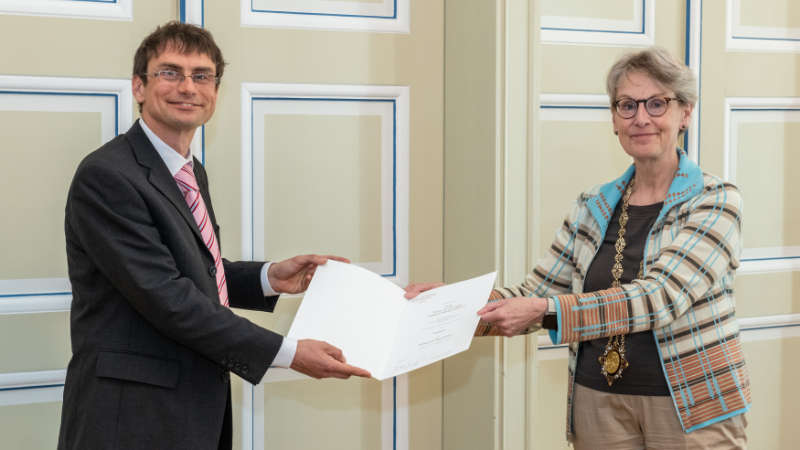JOINT PRESS RELEASE
During a small ceremony on May 30, 2021, which was in keeping with the pandemic regulations, the Rector of TU Dresden, Prof. Ursula M. Staudinger, handed over the certificate of appointment to Prof. Friedrich. This ceremony was the official start signal for the professorship, which draws upon expertise in physics, engineering and biology. The tenure-track professorship “Biological Algorithms” is located at the Cluster of Excellence Physics of Life (PoL) of TU Dresden and is associated with the Center for Advancing Electronics Dresden (cfaed) and the Center for Molecular and Cellular Bioengineering (CMCB). In addition, Prof. Friedrich teaches at the Faculty of Physics.
These diverse affiliations already indicate the strongly interdisciplinary research at the new Chair, which closely links the disciplines of physics, biology and engineering. “The Cluster of Excellence Physics of Life provides an ideal, collaborative environment for our interdisciplinary research that is unique in Europe. We benefit from working closely with engineers at cfaed to apply methods from engineering, such as information theory, to biological systems. Conversely, nature’s algorithms can prompt new, bio-inspired engineering solutions, for example, to synchronize clocks in electronic circuits,” explains Benjamin Friedrich.
How do biological cells and tissues process information? And how do they organize themselves into functional structures during embryonic development and regeneration? These questions can no longer be answered in the lab alone; theoretical biophysicists, such as those in Benjamin Friedrich’s research group, are also needed to develop mathematical models of these complex biological systems. Ideally, fundamental mechanisms, i.e. biological algorithms, can be uncovered and sometimes lead to unexpected, innovative experiments.
One of these research topics are biological clocks. On the surface of our respiratory tract, so-called cilia beat with a common rhythm to expel dirt or viruses. These cilia can beat even when removed from their cell, provided that chemical energy is supplied: each cilium is thus a biological clock. To understand how thousands of these cilia synchronize without a “conductor”, the researchers, led by Prof. Friedrich, use methods from nonlinear dynamics, statistical physics and hydrodynamic simulations.
Another topic being researched at the Chair involves the navigation of cells, such as germ cells. Sperm swim to the egg, driven by the continuous beat of their flagella. But how do they home in on their destination? Chemical cues released by the egg guide them. On their journey, the individual sperm must continuously process chemical signals and make directional decisions, despite numerous interfering influences. Here, methods from information theory, such as those being studied at cfaed, help to understand the sophisticated mechanisms behind the sperm’s navigation process.
“Research on biological systems is first and foremost fundamental research. At the same time, the mathematical description of biological model systems, such as swimming sperm cells, bears relevance for reproductive biology; other topics researched in the group such as recently the architecture of liver tissue or how salamanders can regrow lost limbs, may one day help medicine to develop new therapies,” adds Prof. Friedrich.
You can get to know the research group at the Dresden Long Night of Science (#LNdWDD) on July 9, 2021. For topical reasons, this year we will show how the spread of a virus can be modelled mathematically.
Why the trained mathematician became hooked by biophysics and is now fascinated by diatoms and molecular motors is revealed in this short interview with him. (Link: https://tud.link/8b6i)
Link to the Long Night of Science (LNdWDD) activities of the Friedrich group: https://tud.link/bprn
Press photo
Copyright: Michael Kretzschmar
Picture description: Prof. Ursula M. Staudinger, Rector of TU Dresden, hands over the certificate of appointment to Prof. Benjamin Friedrich, May 30, 2021.
About PoL - Cluster of Excellence Physics of Life
The Cluster of Excellence Physics of Life (PoL) at TU Dresden focuses on the laws of physics that underlie the organization of life into molecules, cells and tissues. At the cluster, physicists, biologists and computer scientists join forces to investigate how active matter organizes itself into predetermined structures in cells and tissues, thus giving rise to life. PoL is funded by the DFG as part of the Excellence Strategy. It is a collaboration between scientists from TU Dresden and research institutions of the DRESDEN-concept network, such as the Max Planck Institute for Molecular Cell Biology and Genetics (MPI-CBG), the Max Planck Institute for the Physics of Complex Systems (MPI-PKS), the Leibniz Institute of Polymer Research (IPF) and the Helmholtz-Zentrum Dresden-Rossendorf (HZDR).
www.physics-of-life.tu-dresden.de
About cfaed - Center for Advancing Electronics Dresden
The cfaed is a research cluster at Technische Universität Dresden (TUD). As an interdisciplinary research center for perspectives in electronics, it is located at TUD as a Central Academic Unit and integrates members from extramural research institutions in Saxony and Saxon-Anhalt as well as TU Chemnitz. The Cluster is dedicated to the fundamentals of sustainable information technologies that would not be possible with the continuation of today’s silicon-based components. To achieve its goals, the cfaed combines a thirst for knowledge in the natural sciences with the innovative power of the engineering sciences.
www.cfaed.tu-dresden.de
Further information:
Prof. Benjamin M. Friedrich
Tel.: +49 351 463-42341
Email: benjamin.m.friedrich@tu-dresden.de
Bianka Claus
DFG Cluster of Excellence Physics of Life (PoL), TU Dresden
Public relations
Tel.: +49 351 463-40133
Email: bianka.claus@tu-dresden.de
Matthias Hahndorf
Center for Advancing Electronics Dresden – cfaed, TU Dresden
Science Communication
Tel.: +49 351 463-42847
Email: matthias.hahndorf@tu-dresden.de
